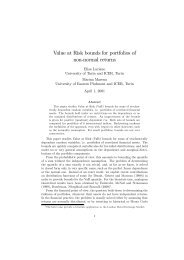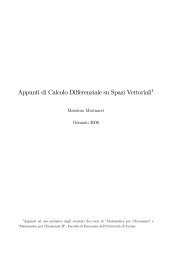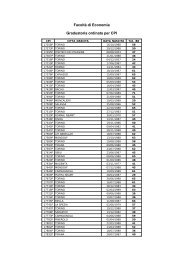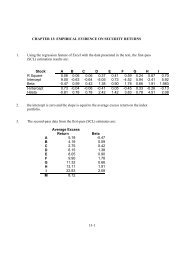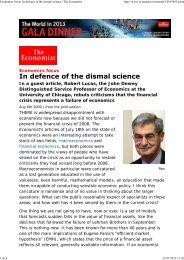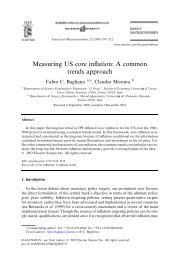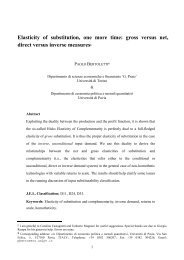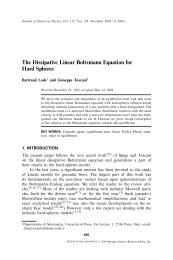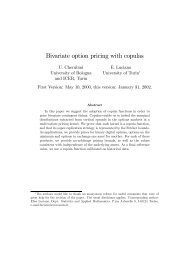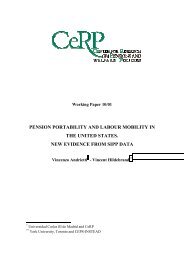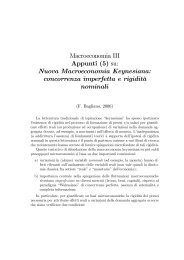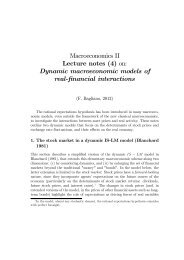The Intuition Behind Black-Litterman Model Portfolios - Computer ...
The Intuition Behind Black-Litterman Model Portfolios - Computer ...
The Intuition Behind Black-Litterman Model Portfolios - Computer ...
You also want an ePaper? Increase the reach of your titles
YUMPU automatically turns print PDFs into web optimized ePapers that Google loves.
InvestmentManagementDivision<strong>The</strong> <strong>Intuition</strong> <strong>Behind</strong> <strong>Black</strong>-<strong>Litterman</strong><strong>Model</strong> <strong>Portfolios</strong>■ In this article and as our title suggests, we demonstrate a method forunderstanding the intuition behind the <strong>Black</strong>-<strong>Litterman</strong> asset allocation model.■ To do this, we use examples to show the difference between the traditional meanvarianceoptimization process and the <strong>Black</strong>-<strong>Litterman</strong> process. We show that themean-variance optimization process, while academically sound, can produceresults that are extreme and not particularly intuitive. In contrast, we show thatthe optimal portfolios generated by the <strong>Black</strong>-<strong>Litterman</strong> process have a simple,intuitive property:− <strong>The</strong> unconstrained optimal portfolio is the market equilibrium portfolioplus a weighted sum of portfolios representing an investor’s views.− <strong>The</strong> weight on a portfolio representing a view is positive when theview is more bullish than the one implied by the equilibrium andother views.− <strong>The</strong> weight increases as the investor becomes more bullish on theview as well as when the investor becomes more confident aboutthe view.December 1999
Goldman Sachs Investment ManagementInvestment Management ResearchGoldman Sachs Quantitative Resources GroupGuangliang He (212) 357-3210Robert <strong>Litterman</strong> (212) 902-1677Copyright 1999 Goldman, Sachs & Co. All rights reserved.<strong>The</strong> information in this publication is for your private information and is not intended as an offer or solicitation to buy or sell any securities.<strong>The</strong> information in this publication is for your private information and should not be construed as financial advice and it is not intended as an offer orsolicitation to buy or sell any securities. <strong>The</strong> sole purpose of this publication is to inform the reader about the intuition behind the <strong>Black</strong>-<strong>Litterman</strong> modelportfolios and is not intended as a solicitation for any Goldman Sachs product or service.______________________________________________ 1 ____________________________________________Investment Management Research<strong>The</strong> <strong>Intuition</strong> <strong>Behind</strong> <strong>Black</strong>-<strong>Litterman</strong><strong>Model</strong> <strong>Portfolios</strong>
Goldman Sachs Investment ManagementExecutive SummarySince publication in 1990, the <strong>Black</strong>-<strong>Litterman</strong> asset allocation model hasgained wide application in many financial institutions. As developed in theoriginal paper, the <strong>Black</strong>-<strong>Litterman</strong> model provides the flexibility tocombine the market equilibrium with additional market views of theinvestor. In the <strong>Black</strong>-<strong>Litterman</strong> model, the user inputs any number ofviews or statements about the expected returns of arbitrary portfolios, andthe model combines the views with equilibrium, producing both the set ofexpected returns of assets as well as the optimal portfolio weights.In contrast to the <strong>Black</strong>-<strong>Litterman</strong> model, in the traditional mean-varianceapproach the user inputs a complete set of expected returns 1 , and theportfolio optimizer generates the optimal portfolio weights. However,users of the standard portfolio optimizers often find that their specificationof expected returns produces output portfolio weights which may not makesense (due to the complex mapping between expected returns and portfolioweights and the absence of a natural starting point for the expected returnassumptions).In this article, we use examples to illustrate the difference between thetraditional mean-variance optimization process and the <strong>Black</strong>-<strong>Litterman</strong>process. In so doing, we demonstrate how the <strong>Black</strong>-<strong>Litterman</strong> approach 2provides both a reference point for expected return assumptions as well as asystematic approach to deviating from this point to express one’s marketviews.<strong>The</strong> Traditional Mean-Variance Approach<strong>The</strong> Markowitz formulation of the portfolio optimization problem is abrilliant quantification of the two basic objectives of investing: maximizingexpected return and minimizing risk. Having formed the foundation ofportfolio theory for the nearly half a century since its publication, thisframework has stood the test of time in the academic world. Unfortunately,in the practical world of investment management, the Markowitzframework has had surprisingly little impact. Why is that the case? We citetwo reasons.First, investment managers tend to focus on small segments of theirpotential investment universe—picking stocks and other assets that theyfeel are undervalued, finding assets with positive momentum, or identifyingrelative value trades. Unfortunately, the Markowitz formulationunrealistically requires expected returns to be specified for everycomponent of the relevant universe, which in practice is typically definedby a broad benchmark.1 Throughout this paper for simplicity we use the phrase ‘expected return’ to refer to ‘expected excess return over the one-period riskfreerate.’2 <strong>The</strong> <strong>Black</strong>-<strong>Litterman</strong> model starts with equilibrium expected returns (as derived via the Capital Asset Pricing <strong>Model</strong>). This set ofexpected returns is the neutral reference point of the <strong>Black</strong>-<strong>Litterman</strong> model.______________________________________________ 2 ____________________________________________Investment Management Research<strong>The</strong> <strong>Intuition</strong> <strong>Behind</strong> <strong>Black</strong>-<strong>Litterman</strong><strong>Model</strong> <strong>Portfolios</strong>
Goldman Sachs Investment ManagementSecond, investment managers tend to think in terms of weights in aportfolio rather than balancing expected returns against the contribution toportfolio risk—the relevant margin in the Markowitz framework. Whenmanagers try to optimize using the Markowitz approach, they usually findthat the portfolio weights returned by the optimizer (when not overlyconstrained) tend to appear to be extreme and not particularly intuitive. Inpractice most managers find that the effort required to specify expectedreturns and constraints that lead to reasonable answers does not lead to acommensurate benefit. Indeed this was the original motivation for <strong>Black</strong>and <strong>Litterman</strong> to develop their approach.Unstable Behavior inPortfolio Weights usingOptimizers<strong>The</strong> following example demonstrates the unstable behavior of the optimalweights that can occur when using optimizers. In Chart 1A, we assume theinvestor has only one view about the markets: German equity willoutperform European equities by 5% per year. Since our investor does nothave a complete set of expected returns for all markets, she starts by settingthe expected returns for all countries equal to 7 percent. To incorporate herview, she then shifts the expected return for Germany up by 2.5% andshifts the expected return for France and the United Kingdom down by2.5 percent.What this investor finds is that using equal means does not compensate forthe different levels of risk in assets of different countries and tends togenerate very extreme portfolios. Chart 1A shows that using the equalexpected returns as the starting point results in optimal weights of -33.5%in Germany and 71.4% in Australia. A small shift in the expected returnsfor the European equities (2.5% for Germany, -2.5% for France and theUnited Kingdom) causes huge swings in the weights for these countries.<strong>The</strong> weight for France now is -94.8 percent!Chart 1A. Optimal Weights, Traditional Mean-Variance ApproachStarting from Equal Expected Returns100.0%75.0%71.4%50.0%25.0%0.0%-25.0%-50.0%-33.5%-75.0%-100.0%-94.8%Equal Expected ReturnsExpected Returns Shifted for European Countries-125.0%AUL CAN FRA GER JAP UKG USAThis chart is to be used for illustrative purposes only.______________________________________________ 3 ____________________________________________Investment Management Research<strong>The</strong> <strong>Intuition</strong> <strong>Behind</strong> <strong>Black</strong>-<strong>Litterman</strong><strong>Model</strong> <strong>Portfolios</strong>
Goldman Sachs Investment ManagementSpecifying a Starting Pointfor Expected ReturnsTranslating Views intoExpected Returns<strong>Black</strong> and <strong>Litterman</strong> also demonstrated the shortcomings of several othermethods for specifying a starting point for expected returns. <strong>The</strong>y pointedout that a better choice for the neutral expected returns is to use theequilibrium expected returns as developed by <strong>Black</strong>. A major advantage ofthis approach is that it results in market capitalization portfolio weightsbeing optimal for an investor using the mean-variance approach. Now,armed with the equilibrium expected returns 3 as the neutral starting point,the investor translates her view into expected returns.<strong>The</strong>re are many different ways to translate the view to expected returns.For example, the investor could simply shift the expected return forGermany to be 5% higher than the weighted average equilibrium expectedreturns for the rest of Europe, but this approach may suggest that Germanyoutperforms the rest of the world. To be precise in expressing her view,she sets the expected return for Germany 5% higher than the (marketcapitalization) weighted average of the expected returns of France and theUnited Kingdom. She sets the sum of market capitalization-weightedexpected returns for the European countries as unchanged from theequilibrium value. She keeps the difference between the expected returnsof France and the United Kingdom unchanged from the equilibriumdifference in value. Chart 1B demonstrates that since the equilibriumalready implies that Germany will outperform the rest of Europe, thechange in the expected returns is actually quite small.Chart 1B. Expected Returns, Traditional Mean-Variance ApproachStarting from Equilibrium Expected Returns0.120.10.6%1.7%Equilibrium Expected ReturnsE. R. Shifted for European Countries0.080.4%0.060.040.020AUL CAN FRA GER JAP UKG USAThis chart is to be used for illustrative purposes only.3 Throughout our examples, we use δ = 25 . as the risk aversion parameter representing the world average risk tolerance.______________________________________________ 4 ____________________________________________Investment Management Research<strong>The</strong> <strong>Intuition</strong> <strong>Behind</strong> <strong>Black</strong>-<strong>Litterman</strong><strong>Model</strong> <strong>Portfolios</strong>
Goldman Sachs Investment ManagementDetermining OptimalPortfolio WeightsChart 1C shows the optimal portfolio weights computed by solving themean-variance problem. Using the equilibrium expected returns, theoptimal portfolio weights are the market portfolio weights. However, whenthe view about Germany versus the rest of Europe is incorporated, eventhough the changes of the expected returns from the equilibrium expectedreturns are small and are limited for European countries only, the optimalportfolio is quite different from what one would have expected: theincreased weight in the German market and the decreased weights in theUnited Kingdom and France markets are expected, but the reduced weightsin Australia and Canada and the increased weights in Japan and theUnited States are very puzzling. Since the investor does not have any viewon these countries, why should she adjust the weight in these countries?Presumably it is because of the way the views are being translated intoexpected returns. As we can see, the investor has already tried to translatethe view into the expected returns. Can she possibly do better?Chart 1C. Optimal Portfolio Weights, Traditional Mean-Variance ApproachStarting from Equilibrium Expected Returns80.0%60.0%40.0%20.0%0.0%-20.0%-40.0%Equilibrium WeightsE. R. Shifted for European CountriesAUL CAN FRA GER JAP UKG USAThis chart is to be used for illustrative purposes only.<strong>The</strong> <strong>Black</strong>-<strong>Litterman</strong> AssetAllocation <strong>Model</strong><strong>The</strong> <strong>Black</strong>-<strong>Litterman</strong> asset allocation model addresses those practical issuesin using the Markowitz framework by allowing the portfolio manager toexpress views about portfolios, rather than a complete vector of expectedreturns on all assets. In the simplest of contexts—when there is nobenchmark or constraints—the optimal portfolio is very intuitive. It issimply a set of deviations from market capitalization weights in thedirections of portfolios about which views are expressed. Here the <strong>Black</strong>-<strong>Litterman</strong> model provides the appropriate weights on the portfolios, basedon stated expected returns on the portfolios and degrees of confidence inthese views. <strong>The</strong> model balances the contribution to expected return ofeach of the portfolios about which a view is expressed against itscontribution to overall portfolio risk. <strong>The</strong>se results are transparent andintuitive.______________________________________________ 5 ____________________________________________Investment Management Research<strong>The</strong> <strong>Intuition</strong> <strong>Behind</strong> <strong>Black</strong>-<strong>Litterman</strong><strong>Model</strong> <strong>Portfolios</strong>
Goldman Sachs Investment Management<strong>The</strong> real power of the <strong>Black</strong>-<strong>Litterman</strong> model arises when there is abenchmark, a risk or beta target, or other constraints. In these contexts, theoptimal weights are no longer obvious or intuitive. Nonetheless, themanager can be confident that the same tradeoff of risk and return—whichleads to intuitive results that match the manager’s intended views in theunconstrained case—remains operative when there are constraints.Market Equilibrium:Reference Point for the<strong>Black</strong>-<strong>Litterman</strong> <strong>Model</strong><strong>The</strong> <strong>Black</strong>-<strong>Litterman</strong> model starts with equilibrium expected returns.According to the Capital Asset Pricing <strong>Model</strong> (CAPM), prices will adjustuntil the expected returns of all assets in equilibrium are such that if allinvestors hold the same belief, the demand for these assets will exactlyequal the outstanding supply. This set of expected returns is the neutralreference point of the <strong>Black</strong>-<strong>Litterman</strong> model. <strong>The</strong> investor then canexpress her views about the markets.In the <strong>Black</strong>-<strong>Litterman</strong> model, a view is a general statement about theexpected return for any portfolio. 4 <strong>The</strong>se views are combined with themarket equilibrium expected returns. 5 In the case when the investor doesnot have any views about the markets, the expected returns from the <strong>Black</strong>-<strong>Litterman</strong> model match the equilibrium, and the unconstrained optimalportfolio is the market equilibrium (capitalization weights) portfolio. In thecase when the investor has one or more views about the market, the <strong>Black</strong>-<strong>Litterman</strong> approach combines the information from the equilibrium andtilts the optimal portfolio away from the market portfolio in the direction ofthe investor’s views.Expected Returns: OneMarket View<strong>The</strong> view that German equity will outperform the rest of Europe is nowprecisely expressed as an expected return of 5% for the portfolio of a longposition in German equity and short positions of market capitalizationweights for the rest of the European markets. <strong>The</strong> <strong>Black</strong>-<strong>Litterman</strong> modeluses these inputs to generate a set of expected returns 6 .In contrast to the traditional approach, the <strong>Black</strong>-<strong>Litterman</strong> model adjustsall of the expected returns away from their starting values in a mannerconsistent with the view being expressed. Because the view is expressedon the portfolio of a long position in German equity and short positions inthe rest of the European markets, the expected return on this portfolio israised from the value implied by the equilibrium—but is still below the 5%expressed in the view. This is quite natural because the view includes adegree of uncertainty associated with it, and thus the <strong>Black</strong>-<strong>Litterman</strong>model is averaging the view with the equilibrium.4 Mathematically, a view is expressed as pµ = q+ ε , where µ is the vector of the expected returns, p is the weights of the portfoliorepresenting the view, q is the expected return of the portfolio. <strong>The</strong> uncertainty of the view is represented by the presence of anormally distributed random variable ε with variance being ω . <strong>The</strong> confidence level of the view is 1 ω .5 See Appendix B for the formula used to compute the expected returns of the <strong>Black</strong>-<strong>Litterman</strong> model.6 Except otherwise noted, throughout this article, the confidence level on a view is calibrated so that the ratio between the parametersω , (defined in footnote 3) and τ (defined in Appendix B, number 2) is equal to the variance of the portfolio in the view, p′Σ p.<strong>The</strong>re is no need to separately specify the value of τ since only the ratio ωτ enters the <strong>Black</strong>-<strong>Litterman</strong> expected returns formula.______________________________________________ 6 ____________________________________________Investment Management Research<strong>The</strong> <strong>Intuition</strong> <strong>Behind</strong> <strong>Black</strong>-<strong>Litterman</strong><strong>Model</strong> <strong>Portfolios</strong>
Goldman Sachs Investment ManagementFrom the graph of the expected returns in Chart 2A, it seems counterintuitiveto see that the expected returns for both France and the UnitedKingdom are raised. On the contrary, the view expressed does not sayFrance or the United Kingdom will go down, it only says that they willunder-perform Germany. Since both France and the United Kingdom arepositively correlated with the view portfolio and the view raises theexpected return of this portfolio, it is natural to see the expected returns onFrance and the United Kingdom increase as well. <strong>The</strong> same intuitionapplies to the other countries in Chart 2A.Chart 2A. Expected Returns, <strong>Black</strong>-<strong>Litterman</strong> <strong>Model</strong>One View on Germany versus Rest of Europe12.0%10.0%Equilibrium Expected Returns<strong>Black</strong>-<strong>Litterman</strong> E.R.8.0%6.0%4.0%2.0%0.0%AUL CAN FRA GER JAP UKG USAThis chart is to be used for illustrative purposes only.Optimal Portfolio Weights:One Market View<strong>The</strong> optimal portfolio weights in Chart 2B are computed by solving themaximization problem. Compared to the equilibrium weights, the optimalportfolio increases the weight in Germany and decreases the weights inboth France and the United Kingdom. One can see that the deviations fromthe equilibrium weights are proportional to the portfolio of long Germanyand short France and the United Kingdom—exactly the portfoliorepresenting the investor’s view. This result is very intuitive. Since theinvestor has a view about this portfolio, she simply invests in this portfolio,on top of her neutral weights, the equilibrium weights.______________________________________________ 7 ____________________________________________Investment Management Research<strong>The</strong> <strong>Intuition</strong> <strong>Behind</strong> <strong>Black</strong>-<strong>Litterman</strong><strong>Model</strong> <strong>Portfolios</strong>
Goldman Sachs Investment ManagementChart 2B. Optimal Portfolio Weights, <strong>Black</strong>-<strong>Litterman</strong> <strong>Model</strong>One View on Germany versus the Rest of Europe80.0%Equilibrium Weights60.0%Optimal Portfolio40.0%20.0%0.0%-20.0%AUL CAN FRA GER JAP UKG USAThis chart is to be used for illustrative purposes only.Optimal Deviation: OneMarket ViewIn Chart 2C, one can see that the deviations of the optimal portfolio fromthe equilibrium weights are exactly proportional to the portfolio of a longposition in Germany and a short position of market capitalization-weightedFrance and the United Kingdom. This result is not coincidental, as itillustrates a very important property of the <strong>Black</strong>-<strong>Litterman</strong> model. Ingeneral, the unconstrained optimal portfolio from the <strong>Black</strong>-<strong>Litterman</strong>model is the market equilibrium portfolio plus a weighted sum of theportfolios about which the investor has views.Chart 2C. Optimal Deviations from Equilibrium Weights<strong>Black</strong>-<strong>Litterman</strong> <strong>Model</strong>One View on Germany versus Rest of Europe50.0%25.0%0.0%-25.0%AUL CAN FRA GER JAP UKG USAThis chart is to be used for illustrative purposes only.______________________________________________ 8 ____________________________________________Investment Management Research<strong>The</strong> <strong>Intuition</strong> <strong>Behind</strong> <strong>Black</strong>-<strong>Litterman</strong><strong>Model</strong> <strong>Portfolios</strong>
Goldman Sachs Investment ManagementTwo Market ViewsIn Chart 3A, in addition to the original view that German equity willoutperform the rest of the European markets, the investor has another viewthat the Canadian equity market will outperform the US equity market by3% per annum. <strong>The</strong> deviations of optimal portfolio weights fromequilibrium weights show an overweight in Germany and underweight in amarket capitalization-weighted portfolio of France and the UnitedKingdom, which is the direct result of the first view. It also shows anoverweight in Canada and underweight in the United States, which is thedirect result of the second view. <strong>The</strong> weights are shown in Chart 3B.Chart 3A. Weights of <strong>Portfolios</strong> in the Views and Optimal Deviations<strong>Black</strong>-<strong>Litterman</strong> <strong>Model</strong> with Two Views150.0%100.0%50.0%0.0%-50.0%-100.0%-150.0%Germany versus Rest of EuropeCanada versus the United StatesOptimal DeviationsAUL CAN FRA GER JAP UKG USAThis chart is to be used for illustrative purposes only.Chart 3B. Portfolio Weights, <strong>Black</strong>-<strong>Litterman</strong> <strong>Model</strong> with Two Views75.0%Equilibrium Wieghts50.0%Optimal Portfolio Weights25.0%0.0%-25.0%AUL CAN FRA GER JAP UKG USAThis chart is to be used for illustrative purposes only.______________________________________________ 9 ____________________________________________Investment Management Research<strong>The</strong> <strong>Intuition</strong> <strong>Behind</strong> <strong>Black</strong>-<strong>Litterman</strong><strong>Model</strong> <strong>Portfolios</strong>
Goldman Sachs Investment ManagementChange of Market ViewDegree of Confidence in theMarket View<strong>The</strong> next question is: how does the weight on a portfolio change when theview changes? What will happen if the investor’s view on Canada versusthe United States is more bullish? For example, the expected return on theportfolio changes from 3% to 4%, while everything else stays the same.Inputting all these parameters into the <strong>Black</strong>-<strong>Litterman</strong> model, the weighton the Canada versus the United States increases. In general, keepingeverything else fixed, the weight on a portfolio increases as the expectedreturn of the view increases. This property is quite intuitive, since it isnatural for the investor to invest more in the portfolio when she believes thereturn on the portfolio is higher.One of the features of the <strong>Black</strong>-<strong>Litterman</strong> model is that the investor canexpress different degrees of confidence about the views. What will happento the weight on a portfolio when the investor becomes less confident aboutthe view on the portfolio? Suppose now the investor still believes Germanywill outperform the rest of Europe by 5% per annum, but she has lessconfidence in the view. Suppose she is only half as confident as in theprevious example. In addition, we assume the investor’s view on theportfolio of Canada versus USA is unchanged at 4% expected return. <strong>The</strong>magnitude of the weight on the portfolio of Germany versus the rest ofEurope decreases, which is also very intuitive. If the investor has lessconfidence in a view, she would take less risk in the view, everything elseremaining the same. <strong>The</strong>se effects are illustrated in chart 4.When will the weight on a portfolio be positive, negative, or zero? It turnsout that the sign of the weight on a portfolio also has a very intuitivemeaning. If the expected return of the portfolio is identical to the expectedreturn on the same portfolio generated by the <strong>Black</strong>-<strong>Litterman</strong> modelwithout the view, the view has no impact at all. Since we already know thatthe weight on a portfolio is an increasing function of the strength of theview, we can deduce that the weight on the portfolio is positive, if and onlyif, the view is more bullish than implied by using the <strong>Black</strong>-<strong>Litterman</strong>model without this particular view.Chart 4.Weights on <strong>Portfolios</strong> in the Views0.6Germany versus the Rest of EuropeCanada versus the United States0.40.20Example 3 More Bullish on Canada/USA Less Confident onGermany/EuropeThis chart is to be used for illustrative purposes only.______________________________________________ 10 ____________________________________________Investment Management Research<strong>The</strong> <strong>Intuition</strong> <strong>Behind</strong> <strong>Black</strong>-<strong>Litterman</strong><strong>Model</strong> <strong>Portfolios</strong>
Goldman Sachs Investment ManagementAll these examples display a very important property of the <strong>Black</strong>-<strong>Litterman</strong> model: an unconstrained investor using the model will invest firstin the market portfolio, then in the portfolios representing the views. Shewill never deviate from the market capitalization-weighted portfolio on theassets about which she does not have views.<strong>The</strong> Constrained OptimalPortfolioRisk ConstraintArriving at the optimal portfolio is somewhat more complex in the presenceof constraints. In general, when there are constraints, the easiest way tofind the optimal portfolio is to use the <strong>Black</strong>-<strong>Litterman</strong> model to generatethe expected returns for the assets, and then use a mean-variance optimizerto solve the constrained optimization problem. In these situations, theintuition of the <strong>Black</strong>-<strong>Litterman</strong> model is more difficult to see. However,one can see the intuition in slightly modified forms in a few specialconstrained cases. 7 Again, the portfolios about which the investor hasviews play a critical role in the optimal portfolio construction, even in theconstrained case.In the case of having a risk constraint, the investor’s objective of selectingthe optimal portfolio is to maximize the expected return while keeping thevolatility of the portfolio under the given level. In this case, the optimalportfolio can be found by scaling the solution of the unconstrainedoptimization problem to the desired risk level. In Chart 3A, the investorhas two views. If the investor is targeting a risk level of 20% per annum,she can calculate the constrained optimal portfolio weights by taking theunconstrained optimal weights, multiplying it by the ratio of the targetedrisk level of 20% and the volatility of the unconstrained optimal portfolio.However, because of the scaling, the deviation from the equilibrium is nolonger a weighted sum of the Germany/Europe portfolio and theCanada/USA portfolio only. It has additional exposure coming from thescaling of the market equilibrium portfolio (Chart 5).Chart 5.<strong>Black</strong>-<strong>Litterman</strong> <strong>Model</strong> with Two Views, Risk Constrained75.0%50.0%25.0%0.0%-25.0%-50.0%Equilibrium WeightsConstrained Optimal WeightsDeviations from EquilibriumAUL CAN FRA GER JAP UKG USAThis chart is to be used for illustrative purposes only.7 <strong>The</strong> solutions to the unconstrained optimization problem as well as to several special constrained optimization problems are given inAppendix C.______________________________________________ 11 ____________________________________________Investment Management Research<strong>The</strong> <strong>Intuition</strong> <strong>Behind</strong> <strong>Black</strong>-<strong>Litterman</strong><strong>Model</strong> <strong>Portfolios</strong>
Goldman Sachs Investment ManagementBudget ConstraintIn many cases, in addition to the risk constraint, the investor faces a budgetconstraint which forces the sum of the total portfolio weights to be one.With this constraint, there is a special ‘global minimum-variance portfolio’which minimizes the variance among all possible portfolios satisfying thebudget constraint. Under both the budget constraint and the risk constraint,the optimal portfolio is a linear combination of the unconstrained optimalportfolio and the global minimum variance portfolio. <strong>The</strong> parameters arechosen in the way that the combination satisfies both the risk constraint andthe budget constraint (Chart 6).Chart 6.75.0%<strong>Black</strong>-<strong>Litterman</strong> <strong>Model</strong> with Two ViewsRisk and Budget Constrained50.0%25.0%0.0%-25.0%-50.0%Equilibrium WeightsConstrained Optimal WeightsDeviations from EquilibriumAUL CAN FRA GER JAP UKG USAThis chart is to be used for illustrative purposes only.Beta ConstraintIn the last example, a beta constraint is added to the budget and riskconstraints. A beta constraint forces the beta of the portfolio with respect tothe market portfolio to be one. It can be shown that the optimal portfoliounder all three constraints—risk, budget, and beta—is a linear combinationof the unconstrained optimal portfolio, the minimum-variance portfolio, andthe market equilibrium portfolio. <strong>The</strong> parameters are adjusted in a way thatall three constraints are satisfied (Chart 7).______________________________________________ 12 ____________________________________________Investment Management Research<strong>The</strong> <strong>Intuition</strong> <strong>Behind</strong> <strong>Black</strong>-<strong>Litterman</strong><strong>Model</strong> <strong>Portfolios</strong>
Goldman Sachs Investment ManagementChart 7.75.0%<strong>Black</strong>-<strong>Litterman</strong> <strong>Model</strong> with Two ViewsRisk, Budget, and Beta Constrained50.0%25.0%0.0%-25.0%Equilibrium Weights-50.0%-75.0%Constrained Optimal WeightsDeviations from EquilibriumAUL CAN FRA GER JAP UKG USAThis chart is to be used for illustrative purposes only.<strong>The</strong> Practical Application ofthe <strong>Black</strong>-<strong>Litterman</strong> <strong>Model</strong>In the Quantitative Strategies group 8 at Goldman Sachs Asset Management,we develop quantitative models and use these models to manage portfolios.<strong>The</strong> <strong>Black</strong>-<strong>Litterman</strong> model is the central framework for our modelingprocess. Our process starts with finding a set of views that are profitable.For example, it is well known that portfolios based on certain value factorsand portfolios based on momentum factors are consistently profitable. Weforecast the expected returns on portfolios which incorporate these factorsand construct a set of views. <strong>The</strong> <strong>Black</strong>-<strong>Litterman</strong> model takes these viewsand constructs a set of expected returns on each asset. Although wemanage many portfolios for many clients, using different benchmarks,different targeted risk levels, and different constraints on the portfolios, thesame set of expected returns from the <strong>Black</strong>-<strong>Litterman</strong> model is usedthroughout. Even though the final portfolios may look different due to thedifferences in benchmarks, targeted risk levels and constraints, all portfoliosare constructed to be consistent with the same set of views, and all willhave exposures to the same set of historically profitable return-generatingfactors.8 This group is part of the Quantitative Resources Group and was formerly known as Quantitative Research.______________________________________________ 13 ____________________________________________Investment Management Research<strong>The</strong> <strong>Intuition</strong> <strong>Behind</strong> <strong>Black</strong>-<strong>Litterman</strong><strong>Model</strong> <strong>Portfolios</strong>
Goldman Sachs Investment ManagementConclusionInstead of treating the <strong>Black</strong>-<strong>Litterman</strong> asset allocation model as a “blackbox” which generates expected returns in some mysterious way, we havepresented a method to understand the intuition of the model. With the newmethod, investing using the <strong>Black</strong>-<strong>Litterman</strong> model becomes very intuitive.<strong>The</strong> investor should invest in the market portfolio first, then deviate frommarket weights by adding weights on portfolios representing her views.<strong>The</strong> <strong>Black</strong>-<strong>Litterman</strong> model gives the optimal weights for these portfolios.When the investor has constraints, or a different risk tolerance level fromthe world average, she can always use the expected returns (generated bythe <strong>Black</strong>-<strong>Litterman</strong> model along with the covariance matrix) in a portfoliooptimization package to obtain the optimal portfolio. Unlike a standardmean-variance optimization, the <strong>Black</strong>-<strong>Litterman</strong> model, if properlyimplemented, will always generate an optimal portfolio whose weights arerelatively easy to understand.______________________________________________ 14 ____________________________________________Investment Management Research<strong>The</strong> <strong>Intuition</strong> <strong>Behind</strong> <strong>Black</strong>-<strong>Litterman</strong><strong>Model</strong> <strong>Portfolios</strong>
Goldman Sachs Investment ManagementGeneralThis presentation does not constitute an offer or solicitation to any person in any jurisdiction in which such offeror solicitation is not authorized or to any person to whom it would be unlawful to make such offer orsolicitation. It is the responsibility of any person or persons in possession of this material to inform themselvesof and to observe all applicable laws and regulations of any relevant jurisdiction. Prospective investors shouldinform themselves and take appropriate advice as to any applicable legal requirements and any applicabletaxation and exchange control regulations in the countries of their citizenship, residence or domicile whichmight be relevant to the subscription, purchase, holding, exchange, redemption or disposal of any investments.Information contained herein is believed to be reliable but no warranty is given as to its completeness oraccuracy and views and opinions, whilst given in good faith, are subject to change without notice. Members ofthe Goldman Sachs Asset Management group of companies and their affiliates, connected persons andemployees may from time to time deal, hold or act as market-makers, advisers or brokers in relation to anyinvestments, or derivatives thereof, or be otherwise interested therein.Past performance is not a guide to future performance and the value of investments and the income derived fromthem can go down as well as up. Future returns are not guaranteed and a loss of principal may occur. Changesin exchange rates may cause the value of an investment to increase or decrease. Some investments may berestricted or illiquid, there may be no readily available market and there may be difficulty in obtaining reliableinformation about their value and the extent of the risks to which such investments are exposed. Certaininvestments, including warrants and similar securities, often involve a high degree of gearing or leverage so thata relatively small movement in price of the underlying security or benchmark may result in a disproportionatelylarge movement, unfavourable as well as favourable, in the price of the warrant or similar security. In addition,certain investments, including futures, swaps, forwards, certain options and derivatives, whether on or offexchange, may involve contingent liability resulting in a need for the investor to pay more than the amountoriginally invested and may possibly result in unquantifiable further loss exceeding the amount invested.Transactions in over-the-counter derivatives involve additional risks as there is no market on which to close outan open position; it may be impossible to liquidate an existing position, to assess the value of a position or toassess the exposure to risk. Investors should carefully consider whether such investments are suitable for themin light of their experience, circumstances and financial resources.Opinions expressed are current opinions as of the date appearing in this material only. No part of this materialmay be i) copied, photocopied or duplicated in any form, by any means, or ii) redistributed without GoldmanSachs Asset Management's prior written consent.______________________________________________ 15 ____________________________________________Investment Management Research<strong>The</strong> <strong>Intuition</strong> <strong>Behind</strong> <strong>Black</strong>-<strong>Litterman</strong><strong>Model</strong> <strong>Portfolios</strong>
Goldman Sachs Investment ManagementAppendix ATable 1: Annualized volatilities, market-capitalization weights, and equilibrium expected returns for the equity markets inthe seven countries.CountryEquity IndexVolatility (%)Equilibrium PortfolioWeight (%)Equilibrium ExpectedReturns (%)Australia 16.0 1.6 3.9Canada 20.3 2.2 6.9France 24.8 5.2 8.4Germany 27.1 5.5 9.0Japan 21.0 11.6 4.3UK 20.0 12.4 6.8USA 18.7 61.5 7.6Table 2: Correlations among the equity index returns.Australia Canada France Germany Japan UKCanada 0.488France 0.478 0.664Germany 0.515 0.655 0.861Japan 0.439 0.310 0.355 0.354UK 0.512 0.608 0.783 0.777 0.405USA 0.491 0.779 0.668 0.653 0.306 0.652______________________________________________ 16 ____________________________________________Investment Management Research<strong>The</strong> <strong>Intuition</strong> <strong>Behind</strong> <strong>Black</strong>-<strong>Litterman</strong><strong>Model</strong> <strong>Portfolios</strong>
Goldman Sachs Investment ManagementAppendix B1. <strong>The</strong>re are N assets in the market. <strong>The</strong> market portfolio (equilibrium portfolio) is w eq. <strong>The</strong> covariance ofthe returns is Σ . <strong>The</strong> expected returns: µ is a vector of normally distributed random variables withmean µ .2. <strong>The</strong> average risk tolerance of the world is represented by the risk-aversion parameter δ . <strong>The</strong> equilibriumexpected returns are Π = δΣw eq. <strong>The</strong> CAPM prior distribution for the expected returns is µ = Π + ε( e ) , whereε ( e)is normally distributed with mean zero and covariance τΣ . <strong>The</strong> parameter τ is a scalar measuring theuncertainty of the CAPM prior.v3. <strong>The</strong> user has K views about the market, expressed as Pµ = Q+ ε( ) , where P is a K× N matrix and Q isK -vector, and ε ( v)is normally distributed with mean zero and covariance Ω . <strong>The</strong> user’s views areindependent of the CAPM prior and independent of each other.[ ] [( )]4. <strong>The</strong> mean of the expected returns is µ = ( τΣ)+ P′ Ω P τΣ Π+ P′Ω Q .−−11 − −−1 1 15. <strong>The</strong> investor has the world average risk tolerance. <strong>The</strong> objective of the investor is to maximize the utilityw'µ −δw'Σw2 . <strong>The</strong> unconstrained optimal portfolio is w * = Σ −1µ δ , which can be written asw = w + P′×Λ. Since the columns of matrix P ′ are the portfolios in the user’s view, this means that theequnconstrained optimal portfolio is the market portfolio plus a weighted sum of the portfolios in the user’sviews. <strong>The</strong> weights for these portfolios are given by the elements of the vector Λ , which is given by theformula Λ = τΩ Q δ − [ Ω τ + PΣP′ ] PΣw − [ Ω τ + PΣP′ ] PΣP′τΩQ δ−1 −1 −1 −1eq.6. Let P , Q , and Ω represent the K views held by the investor initially, µ be the expected returns by usingthese views in the <strong>Black</strong>-<strong>Litterman</strong> model, Λ be the weight vector defined above. Assume the investor nowhas one additional view, represented by p , q , and ω . For the new case of K + 1 views, the new weightvector Λ is given by the following formula⎛−1 −1Λ −( q− p′ µ ) A b ( δ( c−b'A b)) ⎞Λ =⎜⎟⎜−1⎝ ( q− p′ µ ) ( δ( c−b'A b))⎟⎠where−1A = Ω τ + PΣP′ , b = PΣp, c = ω τ + p′Σp. Since c− b′ A b>0 , the expression of Λ shows the additionalview will have a positive (negative) weight if q− p′ µ > 0 (q− p′ µ < 0 ), this corresponds to the case wherethe new view on the portfolio p is more bullish (bearish) than implied by the old expected return µ . <strong>The</strong>additional view will have a zero weight if q = p′µ , this corresponds to the case where the new view isimplied by the old expected returns already. In this case, the new view has no impact at all.7. For a particular view k , its weight λ kis an increasing function of its expected return q k. <strong>The</strong> absolutevalue of λ kis an increasing function of its confidence level ω k −1 .______________________________________________ 17 ____________________________________________Investment Management Research<strong>The</strong> <strong>Intuition</strong> <strong>Behind</strong> <strong>Black</strong>-<strong>Litterman</strong><strong>Model</strong> <strong>Portfolios</strong>
Goldman Sachs Investment ManagementAppendix C1. Given the expected returns µ and the covariance matrix Σ , the unconstrained maximization problem−max w′ µ − δw′Σw2 has a solution of w* = ( δ Σ)1 µ .w2. Given the covariance matrix Σ , the minimum variance portfolio is w m Σ ( Σ )− −) = 1 1with all elements being one.ι ι ι , where ι is a vector3. <strong>The</strong> solution to the risk constrained optimization problem, max w ′ µ , subject to w′ Σw≤σ 2 , can be expressed(as w r = σ w *−w *′Σw* , where w* = ( δ Σ)1 µ is the solution of the unconstrained problem.)4. <strong>The</strong> risk and budget constrained optimization problem can be formulated as max w ′ µ , subject to w′ Σw≤σ 2( b) ( m)and w′ ι = 1. Its solution has the form w = aw*+ bw , where a and b are chosen in the way both riskand budget constraints are satisfied.5. <strong>The</strong> risk-, budget-, and beta-constrained optimization problem can be formulated as max w ′ µ , subject tow′ Σw≤σ 2 , w′ ι = 1, and w′ Σw = weq ′ Σ w , where w eqis the market portfolio. <strong>The</strong> solution to the problemeq eqhas the form of w(= aw*+ bw + cw , where a , b , and c are chosen in the way all three constraints areβ ) m( )eqsatisfied.References[1] <strong>Black</strong>, Fischer and Robert <strong>Litterman</strong>, Asset Allocation: Combining Investor Views With Market Equilibrium,Goldman, Sachs & Co., Fixed Income Research, September 1990.[2] <strong>Black</strong>, Fischer and Robert <strong>Litterman</strong>, Global Portfolio Optimization, Financial Analysts Journal, pages 28-43, September-October 1992.[3] <strong>Black</strong>, Fischer, Universal Hedging: Optimizing Currency Risk and Reward in International Equity<strong>Portfolios</strong>, Financial Analysts Journal, pages 16-22, July-August 1989.[4] <strong>Litterman</strong>, Robert, Hot Spots and Hedges, <strong>The</strong> Journal of Portfolio Management, pages 52-75, December1996.[5] Markowitz, Harry, Portfolio Selection, Journal of Finance, pages 77-91, March 1952.______________________________________________ 18 ____________________________________________Investment Management Research<strong>The</strong> <strong>Intuition</strong> <strong>Behind</strong> <strong>Black</strong>-<strong>Litterman</strong><strong>Model</strong> <strong>Portfolios</strong>



